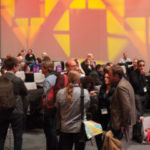
Imagine that the organization you work for is in the midst of planning the technical conference it has sponsored for the last 32 years. The general chair of this year’s committee has solicited $4,000 in contributions from each of 40 laboratories in his field, but one lab gave only $2,000. The conference treasurer wants to decline the contribution because it’s too small. You’re two-and-a-half months from the event, and print deadlines are approaching. How do you advise the committee to proceed?
This was just one scenario presented to a group of 40 planners from the Institute of Electrical and Electronics Engineers (IEEE) who gathered Aug. 25-27 for the first-ever IEEE Planner Summit, at the New York Hilton Midtown in New York City. The session was an exercise in collective intelligence, and all about collaboration. “Case studies are known to be one of the most effective means to transfer knowledge to adult learners,” said Marie Hunter, IEEE’s senior director of meetings, conferences, and events, “who often want relevant, easily applicable lessons that can be garnered through experiences.”
‘It Begins With Us’
IEEE member societies hold more than 1,300 conferences globally each year, and IEEE itself employs planners, including those in attendance at the Planner Summit, who are available to assist in the organization of these events. But because IEEE has offices in California, New York, and New Jersey, some of the planners at the summit had never met each other. “In this age of collaboration and convergence, we have to model those behaviors — it begins with us,” Hunter said. “To do that effectively and to address all the convergence in technologies and communities, we need to work effectively across the enterprise.”
The summit, which Convene attended at IEEE’s invitation, was Hunter’s idea, with the goals of providing information and addressing common topics that come up for IEEE planners, many of whom aren’t aware of all the resources available through the association to assist them. “Because if s such a big organization” — made up of more than 425,000 members across 160 countries and 333 sections — “and because if s so complex,” said Lisa Boyd, CMP, IEEE’s senior manager of event management services,”… we oftentimes don’t know who you’re supposed to go to.”
In the session with the $2,000 contribution, called “Meetings Gone Wrong,” Boyd divided the group into six tables of six to eight planners, and assigned a problem situation to each table. Each team — which Boyd made sure included planners representing different societies within the larger IEEE organization as well as a mix of junior- and senior-level professionals — was given six minutes to come up with what it thought was the best response to its “nightmare scenario,” which was a real-life issue that Boyd had heard about from other planners.
But just when groups thought they had come up with effective solutions, Boyd threw them a curve ball. In the case of the $2,000 contribution: One committee member proposes to list the contributors in two different tiers — gold and silver. What do you do? Team members debated creating tiered levels in the program, declining the contribution altogether (an option quickly rejected), or devising another sponsorship opportunity for the $2,000 contributor that doesn’t include representation in the print program, and shared their solutions with the wider group. Other scenarios presented during the session included what to do when a hurricane threatens your host city, how to deal with a power outage at your headquarters hotel, and how to proceed when the keynoter at your Mothers Against Drunk Driving-sponsored event is arrested for DUI the night before the general session.
Positive Vibes
“For this meditation, we will allow the natural thoughts to flow. I have a thought that I am a peaceful, positive being. I create the thought that I am a positive individual. And I maintain positive thoughts in every situation. I seek solutions to problems. And I focus in on the answers and not on the problems…. I focus to replace the negative thoughts with positive thoughts so that the light of positive thinking empowers me.”
On day two of the Planner Summit, an interactive session called “Hot Button Issues and Solutions” began with a meditation exercise. Led by Beth Surmont, CMP, IEEE’s senior manager of strategic programs, the session was focused primarily on addressing pressing issues that IEEE planners face — recurring problems running the gamut from volunteer management to best practices for issuing gratuities. Knowing that the program had the potential to descend into the negative, Surmont said, “We thought that a way to counter that and make it a productive session instead of just a complaining session would be to throw in some different types of formats and really try to make it as positive and fun as we possibly could.”
Surmont built the session as a miniature version of organizational behavior professor David Cooperrider’s Appreciative Inquiry method, which harnesses the talents of the group to collectively work on tasks and solutions. “The idea of dreaming the best possible end state, envisioning what that solution can be,” Surmont said, “and doing it from a positive standpoint — that’s where it came from.”
Hot Buttons
Prior to the summit, attendees were asked what their major concerns were. Organizers took those responses and grouped them into similar categories, which were then posted on the wall at the beginning of the conference. When participants received their name badges, they also got five small stickers to indicate those issues that they wanted to discuss. “Everybody also got a large sticker that we called their ‘Hot Button.’ You put this on the issue that you absolutely have to talk about,” Surmont said. “It made it easier to pick which would be the top ones.”
Attendees were again divided into six groups, but of their own choosing this time — they were allowed to migrate to the table that would be discussing the issue that most concerned them. To help facilitate the discussion, Surmont combined other elements often found in an unconference format into an “unconference stew.” For instance, in addition to driving the content of the session, participants used a vote-by-text system to indicate their level of agreement with the solution proposed by each group, and were encouraged to rotate tables halfway through the session to work on another issue.
The plan was to create an energetic and positive experience, both by opening the session with a meditation on positivity and by injecting a little fun. “It was the afternoon of the second day, in that two o’clock period,” Surmont said. “Sitting and quiet discussion isn’t really going to work for that.”
On each table was placed a colorful bouncy ball with a smiley face painted on it. Group members were given permission to toss the ball at anyone at their table who made a negative statement. “I didn’t think we would necessarily come up with any big solutions,” Surmont said. “It was more about, can we talk about this in a positive way?”



